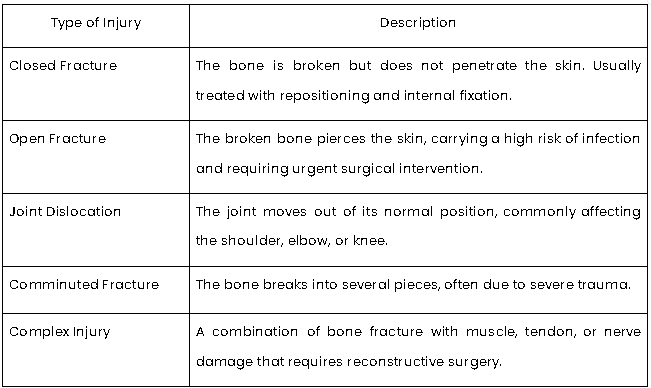By: Geraldus Sigap

Understanding Bone and Trauma Surgery
Bone and trauma surgery, also known as orthopaedic trauma surgery, is a medical field that focuses on the diagnosis and treatment of injuries involving the bones, joints, and surrounding soft tissues (muscles, ligaments, and tendons). These injuries can occur due to accidents, falls, sports activities, or degenerative conditions such as osteoporosis. The main goal of trauma surgery is to restore bone structure and function, relieve pain, and help patients regain mobility and independence as quickly and safely as possible.
Common Causes of Bone and Joint Injuries
Here are some of the most frequent injuries that may require fracture and trauma surgery:

When Is Surgery Needed?
Not all fractures require surgery, but surgical intervention is usually recommended when:
- The fracture is displaced or misaligned.
- The injury involves soft tissue, blood vessel, or nerve damage.
- There is an open fracture that increases the risk of infection.
- The fracture occurs in or near a joint, affecting movement and stability.
- Conservative treatments (like casts or splints) fail to promote proper healing.
How is Fracture and Trauma Surgery Performed?
Surgery is performed to realign and stabilize the bone and promote faster healing. The specific procedure depends on the location and severity of the injury, but generally involves:
- General or regional anesthesia to ensure patient comfort.
- Open reduction, carefully repositioning the bone to its proper alignment.
- Internal fixation using plates, screws, pins, or metal rods to stabilize the bone.
- Wound closure and rehabilitation, where the incision is closed with sterile technique and the patient begins physiotherapy soon after surgery.
- Thanks to medical advances, many of these procedures can now be performed using minimally invasive surgical techniques, resulting in less post-operative pain and a faster recovery time.
Recovery and Rehabilitation
After surgery, patients will undergo a gradual recovery process under the supervision of doctors and physiotherapists. The goal of rehabilitation is to restore muscle strength, joint flexibility, and full movement. Typical recovery stages include:
- Days 1–3: Light exercises and early mobilization with physiotherapy assistance.
- Weeks 1–4: Range-of-motion and muscle-strengthening exercises around the injured area.
- After 4 weeks: Gradual return to light daily activities under medical supervision.
At RS Abdi Waluyo, patients receive personalized recovery programs at the Rehabilitation & Physiotherapy Center, equipped with advanced tools and experienced specialists.
Possible Complications
While modern surgical techniques are highly safe, some potential complications may still occur, such as:
- Post-surgical infection
- Delayed bone healing (delayed union) or failure to heal (non-union)
- Joint stiffness
- Nerve or vascular injury near the fracture site
- Leg length discrepancy or imbalance
Regular follow-up appointments are essential to ensure healing progresses well and to detect complications early.
RS Abdi Waluyo provides specialized care through its Orthopaedic Department, offering a comprehensive approach for bone and trauma surgery. Available services include: Orthopaedic consultation, Fracture and trauma surgery, Minimally invasive fixation procedures, and Post-operative rehabilitation programs. Contact RS Abdi Waluyo at 021-3144989 or make an online appointment via https://abdiwaluyo.com/
FAQ
- Do all bone fractures require surgery?
Some minor fractures can heal with a cast or splint, but surgery is needed if the bone is displaced or involves a joint.
- How long does recovery take after fracture surgery?
It depends on the type and location of the fracture. Typically, bones take 6–12 weeks to heal, accompanied by regular physiotherapy.
- Is fracture surgery safe for elderly patients?
Yes. With thorough preoperative evaluation and modern techniques, surgery can be performed safely even in older patients.
- Do metal implants need to be removed later?
Not always. Most implants can remain in place permanently unless they cause discomfort or irritation.
- When should I see a doctor after an injury?
Immediately after any serious trauma, especially if you experience severe pain, swelling, deformity, or difficulty moving the affected area.
Referensi:
- Sop JL, Sop A. Open Fracture Management. [Updated 2023 Aug 8]. In: StatPearls [Internet]. Treasure Island (FL): StatPearls Publishing; 2025 Jan-. Available from: https://www.ncbi.nlm.nih.gov/books/NBK448083/
- Gosselin RA, Charles A, Joshipura M, et al. Surgery and Trauma Care. In: Debas HT, Donkor P, Gawande A, et al., editors. Essential Surgery: Disease Control Priorities, Third Edition (Volume 1). Washington (DC): The International Bank for Reconstruction and Development / The World Bank; 2015 Apr 2. Chapter 3. Available from: https://www.ncbi.nlm.nih.gov/books/NBK333507/ doi: 10.1596/978-1-4648-0346-8_ch3
